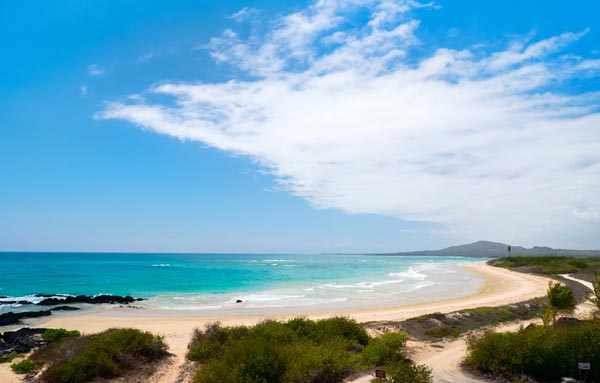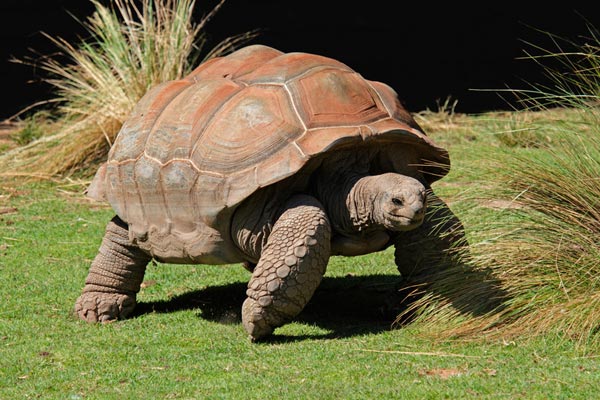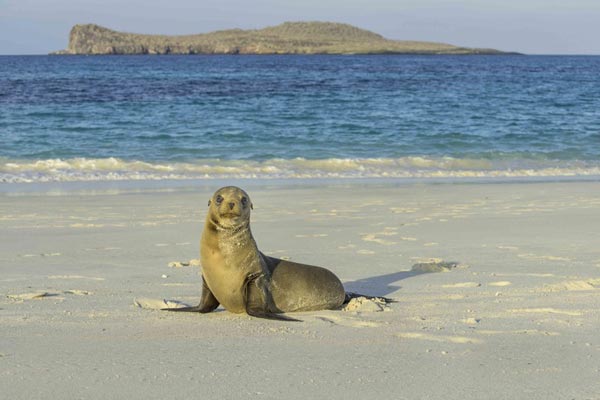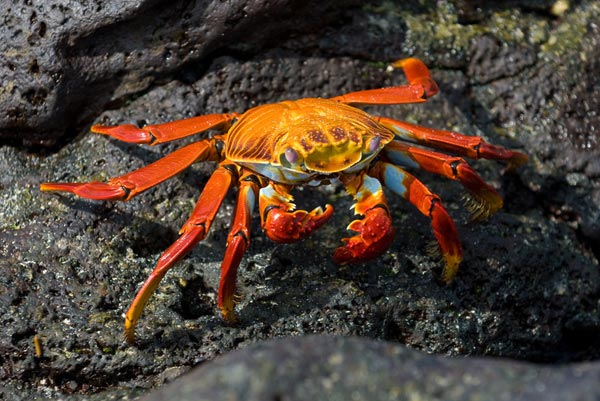Adventure Cruise of the Galápagos Islands
This adventure cruise is focused on the northern islands of the Galápagos archipelago.
Climb aboard the comfortable Daphne (G3) and enjoy extras like included snorkeling gear and the presence of an expert naturalist guide, there to make sense of this unique region.
After a full day of swimming with unique sea life and walking among wildlife that has no fear of humans, enjoy deck-side drinks before retiring to your air-conditioned cabin. Ocean views come standard.

Itinerary for your adventure cruise of the Galápagos Islands
Day 1 Arrive Quito
Arrive in Quito at any time. There are no planned activities, so check into our hotel and enjoy the city. A G Adventures representative will greet you at the hotel and brief you on the various aspects of the tour. If you are not able to attend the welcome meeting, our representative will leave all important information at your hotel’s reception indicating what time to be ready on Day 2 of your trip. If there is any confusion on arrival, please do not hesitate to call the contact number listed in this dossier.
Located 2850m (9348 ft) above sea level, the Ecuadorian capital of Quito enjoys a wonderful spring-like climate, despite the fact that it is only 22 km (14 miles) south of the Equator. Nestled in a valley flanked by mountains, on a clear day several snow-capped volcanoes, including nearby Pichincha, are visible from the city centre. Add to its beautiful location a rich history and well-preserved colonial district, and you begin to understand Quito’s appeal to thousands of tourists every year.

In 1978 UNESCO declared Quito a World Heritage site, and any new development in Quito’s old town is now strictly controlled. Life in Quito tends to be peaceful, though the drivers are fond of using their car horns! There are approximately 2,000,000 inhabitants in the metropolitan area, but the pace is relaxed and the residents hospitable.
Since pre-Columbian times, the site of Quito has been inhabited by the Quitus, the Shyris and the Puruhas. The Inca reached this city before the Spaniards, but levelled it to the ground rather than give it up to the Spanish. The present capital was founded by the Spanish on December 6th, 1534. Quito is separated into two basic sections, the old and the new cities. The old city is full of historical buildings and churches. One of the more noteworthy is the Catedral de Quito, located on the Plaza de la Independencia. Built between 1550 and 1562, it was one of the first neoclassical works in Quito. La Compañía de Jésus Church is considered one of the most beautiful in the Americas. The decorations in the Compañía contain approximately one and one-half tons of gold, and construction of the church took 170 years (1605-1775).
There are several excellent museums scattered throughout the city. The Casa de la Cultura Ecuadoriana has an interesting display of traditional musical instruments and Ecuadorian traditional dress, a large art collection, and a small natural history museum. For archaeology the best museum to visit is the Museo del Banco Central with its well displayed pottery, gold ornaments, skulls showing deformities and early surgical methods, a mummy and many other objects of interest. The small, rounded hill dominating the old town is El Panecillo or ‘the Little Bread Loaf,’ a major Quito landmark. From here there are marvellous panoramic views of the entire city and surrounding volcanoes. You can easily take a trolley (streetcar) or a cab between the Old Town and New Town.
Quito’s large foreign population and steady stream of travellers have given it a varied and vibrant nightlife, and salsotecas and other dance clubs abound. For a real Ecuadorian experience though, be sure and drop by a peña if you can; these are great places for meeting locals and dancing, as well as enjoying local cooking.
Just a couple of hours south of Quito is Parque National Cotopaxi, home to Cotopaxi Volcano (5897 m/19342 ft). the beautiful cone-shaped, snow covered volcano is Ecuador’s second highest peak and the highest active volcano in the world. This is a great spot for a days hiking (up to the refuge on the glacier’s edge) or mountain biking (downhill all the way). True enthusiasts attempt the climb to the summit (overnight excursion). Allow yourself an extra day or two in Quito, before or after your trip, if you want to conquer Cotopaxi.
Warning: Please take care when wandering about the city on your own, as pick pockets and purse-snatchers are common, particularly in the Old Town. Be safe and leave your passport, credit cards, traveller’s cheques and cash you don’t need in the hotel’s safety deposit box. Most Quiteños are honest and genuinely helpful and friendly, but be safe and enjoy the city!
Day 2 San Cristóbal (1B,1L,1D)
Early flight to San Cristóbal the capital of the Galapagos Islands. Upon arrival meet our naturalist guide who will assist with the transfer to our boat. After lunch we will visit the San Cristóbal’s Interpretation Centre to learn more about the natural history, human history, and conservation efforts of the Galapagos Islands.
Flights from Quito to San Cristobal depart between 8:10am and 10:10am depending on the day of the week. These will arrive into the Galapagos between 10:40am and 12:40pm with a refuelling stop in Guayaquil (you will not disembark the plane). You will generally arrive onto the boat in time for lunch on Day 2 before your afternoon activity.
Please note: The National Park charges a visitor fee of USD100, payable on arrival, which funds park maintenance and supervision in the Galapagos, as well as ecological study, conservation and infrastructure development in Ecuador’s other National Parks. Entry fees and the funds they generate for the national park system are among measures taken by the Ecuadorian government to protect its natural heritage.
Estimated Travel Time: 3 hours (By flight)
The Galapagos Islands are located about 1000 km (620 miles) off the Pacific coast of South America. The archipelago is comprised of 13 major islands and scores of islets that served as a living laboratory for Charles Darwin, the renowned evolution theorist. Long before Darwin arrived in the Galapagos, seafarers knew these isolated islands as home to some of the strangest and most wonderful wildlife imaginable, including birds that could swim but no longer fly, aquatic iguanas, dragon-like lizards left over from prehistoric times, and the giant Galapagos tortoises for which the islands were named.
Covering nearly 5000 square km (3100 square miles), the Galapagos Islands are now a National Park. The Galapagos National Park is the institution that controls the preservation of this environment, assisted by the Charles Darwin Research Station. Inaugurated in 1964 and based in Puerto Ayora on Santa Cruz Island, the Charles Darwin Research Station is the one place where visitors can easily see the famous Galapagos Tortoises, which may live up to two hundred years. This is also the training centre for naturalist guides who accompany all visitors landing at more than 40 approved sites on the islands, and members of the international scientific community often come to study at the station.
San Cristóbal is the easternmost island of Galapagos and one of the oldest. The principal town is Puerto Baquerizo Moreno, the capital of the Galapagos.
Day 3 Santa Fé/Plazas (1B,1L,1D)
Set sail and reach Santa Fé Island early mornring. It’s a fairly small and dry island. Also called Barrington, Santa Fé Island is well-known as a great place for watching (and swimming with) sea lions. Along the island’s northern shore you can view the forest of giant Prickly Pear Cactus (Opuntia). Santa Fé is also home to a number of endemic species which have bounced back from various threats to their survival. You may get a chance to see the Galapagos hawk, Galapagos snake, a variety of finches and the Galapagos mockingbird.

In the afternoon, visit South Plaza Island. One of the smallest islands in the Galapagos, South Plaza has one of the largest populations of land iguanas. Walk along a path through a cactus forest and view a combination of dry and coastal vegetation.
Day 4 Genovesa (1B,1L,1D)
In the morning, land at Genovesa Island, an old imploded volcano, where there will be an excursion to Darwin Bay for some fantastic snorkelling opportunities within the a partially eroded crater on the south side of the island.
The second landing is at El Barranco, otherwise known as Prince Phillip’s Steps, on the southern tip of the island. This site is a major breeding ground for red footed boobies and masked boobies can also be seen. Other birds like various species of finches can be seen as well as the Galapagos Mockingbird.
Well to the north of the main Galapagos Island group, Genovesa Island itself is the shape of a horseshoe due to its volcanic history.
Day 5 Santiago/Rábida (1B,1L,1D)
Visit Sullivan Bay on Santiago Island in the morning to witness the striking and fascinating giant lava formations. Very few plants have managed to survive on this island due to the harsh environment and relatively new lava floe. Enjoy a walk along the lava formations before coming to a white coral sand beach, where plentiful sally lightfoot crabs and sea lions can be seen.

In the afternoon, we will take an excursion to Rábida Island, where we will land on a red sand beach. From here a short trail leads to a salt water lagoon, often home to wading flamingos. Another trail goes past the lagoon to the interior, where the revered palo santo trees grow. When burned, the branches of this tree give off a pleasing aroma and ward off mosquitoes. Back on the beach among low-lying bushes nest the prehistoric-looking pelicans. This is the best area for close viewing of these nesting birds, and it’s a rare treat to watch parent pelicans return with gullets full of fish for the squawking youngsters.
Day 6 Santa Cruz/Baltra/Quito (1B)
Take an excursion by “panga” to Black Turtle Cove on Santa Cruz Island to witness the extensive mangrove system and interesting waterway canals. Sea turtles and different species of rays can often be seen in this cove, offering a peaceful and fascinating glimpse into the diversity of the area.
Disembark in Baltra. Transfer to the airport for the flight back to Quito.
Flights from Baltra to Quito depart between 10:00am and 1:00pm depending on the day of the week. These will arrive into Quito between 2:30pm and 5:30pm with a refuelling stop in Guayaquil (you will not disembark the plane). You will arrive back at the hotel in the early evening in time for dinner.
Day 7 Quito (1B)
Depart at any time.
